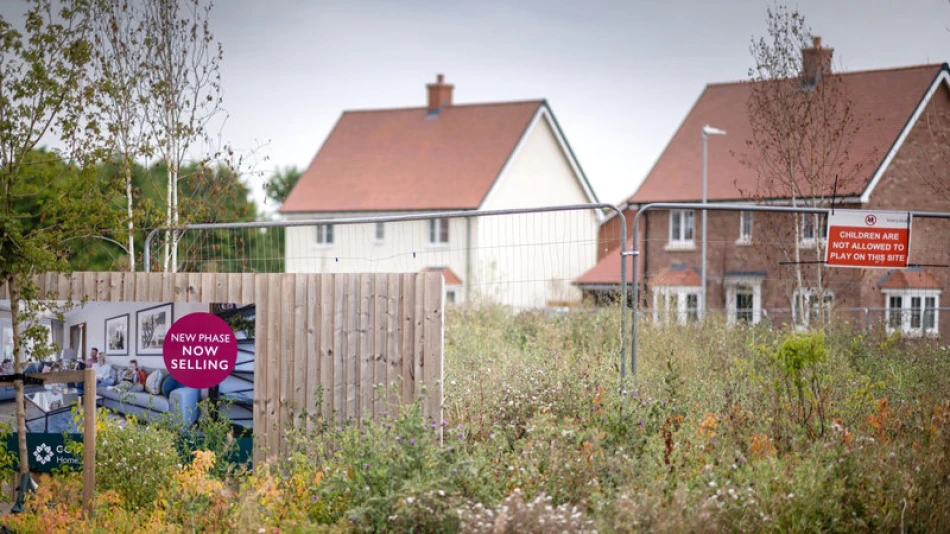
Outrage as New Housing Developments in England Lack Essential Amenities
England's Housing Crisis: Thousands of Homes Built Without Essential Community Infrastructure
Across England, developers are constructing thousands of residential properties while systematically failing to deliver promised community facilities, leaving families stranded in housing estates without schools, playgrounds, shops, or healthcare centers. This pattern reveals a deeper structural problem in England's planning system that prioritizes developer profits over livable communities.
The Reality on the Ground: Isolated Housing Estates
The Paddocks development in Cressing, Essex, exemplifies this crisis. Built by Countryside Homes (owned by Vistry Group), this 225-home project features a playground surrounded by warning signs reading "No Entry" and "No Children." Three years after families moved in, the promised facilities remain incomplete or inaccessible.
Kevin Dell, a local activist, describes the situation starkly: "Houses overlook an unfinished playground. There are no shops, no children's play areas, and even the newly planted trees have died." This scenario repeats across England, where housing developments spring up on town peripheries without adequate public transport or community amenities.
When Local Councils Fight Back
In Westville Park, Surrey, council members took the dramatic step of halting construction on thousands of homes to ensure playground and community facilities would be delivered. The council chair explained their frustration: "Shops, a community center, and playgrounds were supposed to be built once we reached 600 homes. We've exceeded 1,000 homes and found nothing."
The Planning System's Structural Flaws
Steve Chambers, whose "New Homes Campaign" has documented housing projects nationwide for years, identifies a systemic issue: "We're building homes on the edges of towns lacking public transport, where teenagers have nowhere to go independently. Our volunteers have witnessed housing projects without shops, cafes, or adequate play space."
The Paddocks case illustrates how developers exploit planning loopholes. Construction began in 2021, but the local council later took enforcement action against Vistry and Countryside Homes when it became clear the project wasn't built according to planning permission. A new planning application to regularize what had already been constructed wasn't approved until March 2025.
Developer Responses and Legal Obligations
Vistry Group maintains that under planning agreements, they're not obligated to build shops, cafes, or gardens at Paddocks. Regarding the dead trees, the company dismissed this as "common in new plantings" and promised repairs at their own expense. The playground, they claim, will open "this summer" once surrounding landscaping is complete.
The Broader Pattern: Profit Over Community
At Silver End, another nearby development of 350 properties by Redrow Homes, developers rejected community requests for essential facilities despite local residents offering free labor. Council member James Abbott, who has served on planning committees for 26 years, requested space for an early childhood care facility with local craftsmen volunteering their services. Redrow refused.
Redrow defends their position, stating the site came with pre-approved plans including £2.5 million funding for local infrastructure support, but no community center. However, planning meeting minutes reveal Redrow actually offered to create a community hall as part of renegotiating agreement terms—an offer the local council rejected.
Political and Economic Context
Abbott believes developers have gained excessive freedom through planning system changes under both Conservative and Labour governments, positioning them "extremely powerfully to build homes that maximize their profits." This reflects broader tensions in English housing policy between meeting numerical targets and creating sustainable communities.
Market Implications and Future Outlook
This infrastructure deficit represents a significant market failure that could impact property values long-term. Homes without community amenities may struggle to maintain desirability, particularly as buyers become more aware of these issues. The pattern also suggests potential liability risks for developers and local authorities as residents increasingly organize to demand promised facilities.
The crisis highlights fundamental questions about England's approach to housing development: whether the country is building communities or merely constructing isolated residential units that fail to meet basic human needs for social connection and local services.
Most Viewed News

 Sara Khaled
Sara Khaled






